The motto for the 2024 Paris Olympics was “Ouvrons Grand les Jeux”, a phrase that translates as “Games Wide Open”.
The organisers coined it as a nod to their intention to create a spectacle that promoted not only the key values of unity and equality but also enjoyment and emotion.
Their desire was for everyone participating in or witnessing the Games to have memories that would last a lifetime.
The last aspect of that was particularly apt when it came to the women’s football tournament, with there being plenty of emotion attached to each game and so many moments that fans will look back on for years to come.
The gold medal match at the climax of the competition will certainly be one of them, with Brazil and the USA locking horns and showing the best of themselves as they sought to end what had been a strong run for both in the best possible way.
In the end, it was the USWNT who succeeded in attaining the gold medal at PSG’s Parc des Princes, and it was a special moment for new head coach Emma Hayes too, with it being her first major tournament at the helm.
It was far a straightforward victory, with Brazil making the better start and putting on a performance worthy of their place in the last two, but this Women’s 2024 Olympic Football Final tactical analysis will show why they ultimately fell short and why it was the USA who were the happier side at the close of play.
USWNT Vs Brazil 2024 Olympic Final Lineup

Brazil head coach Arthur Elias made just one change to his starting formation from the side that saw off world champions Spain in their semi-final match, but it required significant role rotation as he sought to find the best player combinations around the field.
Young Internacional Femenino forward Priscila was withdrawn from the XI and named among the substitutes, while utility player Adriana moved in the opposite direction.
The Orlando Pride player was handed a start at right wing-back, with new Chicago Red Stars player Ludmila changing to a place among the forward unit, including Jheniffer and the in-form Gabi Portilho.
Former Chelsea Women manager Hayes also made a single alteration to her starting lineup, although she did opt for a different formation too, as the USA moved from the 3-4-3 that had helped them past Germany to a 4-2-3-1.
The new name brought in was that of PSG Féminine midfielder Korbin Albert, with NJ/NY Gotham’s Rose Lavelle dropping to the substitutes.
Captain Lindsey Horan, who also plays her club football in France (for Lyon Féminin), moved into the playmaker role and was flanked by Trinity Rodman and Mal Swanson, whilst Portland Thorns’ Sophia Smith led the line.
Brazil WNT’s Bright Start
Whilst the USA secured the win in the end, it was Brazil who made the stronger start to proceedings, and it was clear from the outset that Elias had developed a game plan that would allow his team to take the game to their opponents and to ensure that they would have to work for their victory.

That was especially noticeable in their defensive play.
Brazil’s high-pressing strategy, deployed throughout the tournament, once again paid off in Paris, making it difficult for the USA to create too many chances inside the final third.
In this case, the ball has fallen at Swanson’s feet, and she has been immediately closed down by Lauren, who has read the play and moved out of line to prevent the Chicago player from turning and running at goal.
The Kansas City Current defender has not always been a headline-attracter as the Olympic tournament has gone on, but there is no doubting her importance to Brazil’s progress into the last two.
She really set the pace for her side when it came to getting tight to opponents in a bid to limit their effectiveness around the field, and her overall display more than justified her inclusion at the expense of others who could have been selected, such as former Arsenal Women player Rafaelle, who was left on the bench.
However, there was a good blend in Brazil’s defensive play and they were just as capable of keeping the USA out in other ways too.
This is where others in the back line, like Tarciane, really come into the equation.
The Houston Dash centre-back is well-suited to making blocks and interceptions and disrupting attacks when opposing sides break behind and look to pull the ball back into the middle.
This happened a few times in the first half of this match, and she was equal to each one and was, therefore, just as instrumental in the USA’s continually frustrated attitude whenever they did get into promising areas.
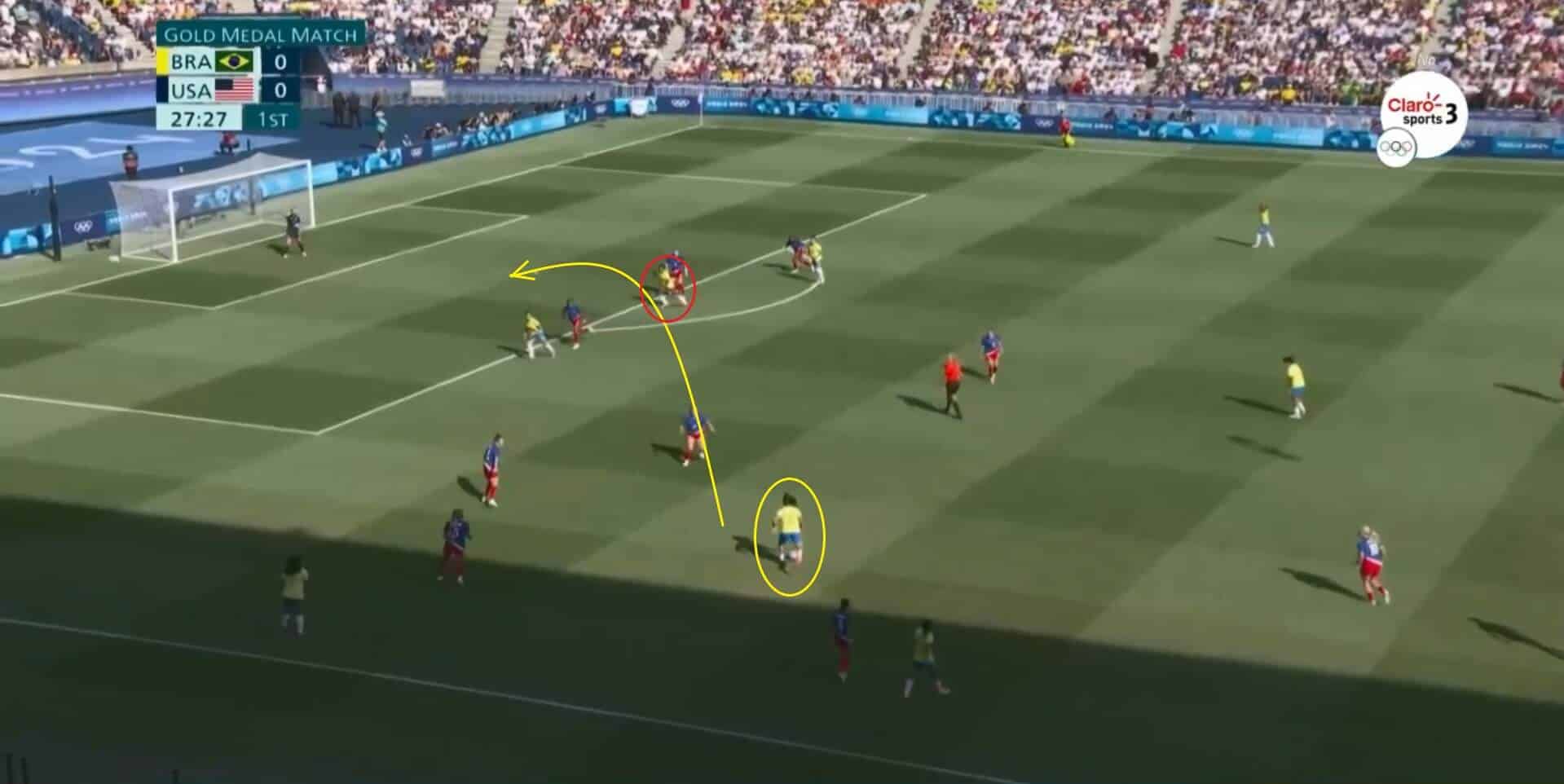
That confidence was just as evident when it came to Brazil’s attacking play too, as was Elias’ desire to keep things simple from a tactical point of view.
As a result, their build-up patterns rarely altered whenever they gained possession, with their aim constantly revolving around shifting the ball up the field in a direct manner and looking to exploit gaps in the USA’s back line before Hayes’ side had had a chance to close them off.
In this case, that has seen the ball fall at the feet of Duda Sampaio and she instantly looked towards the goal area, with the lack of hesitation that she demonstrated in the process of making the pass highlighting the belief that Brazil are playing with at this moment in time.
On this occasion, the chance didn’t quite fall for them, with the ball evading Ludmila and travelling harmlessly behind for a goal kick.
However, the fact that Brazil had already had a chance and had found the back of the net from a similar position (albeit that it was rightly ruled out for offside) shows how dangerous they were when allowed to play with this amount of time and space and how the USA were under significant pressure as the first half went on.
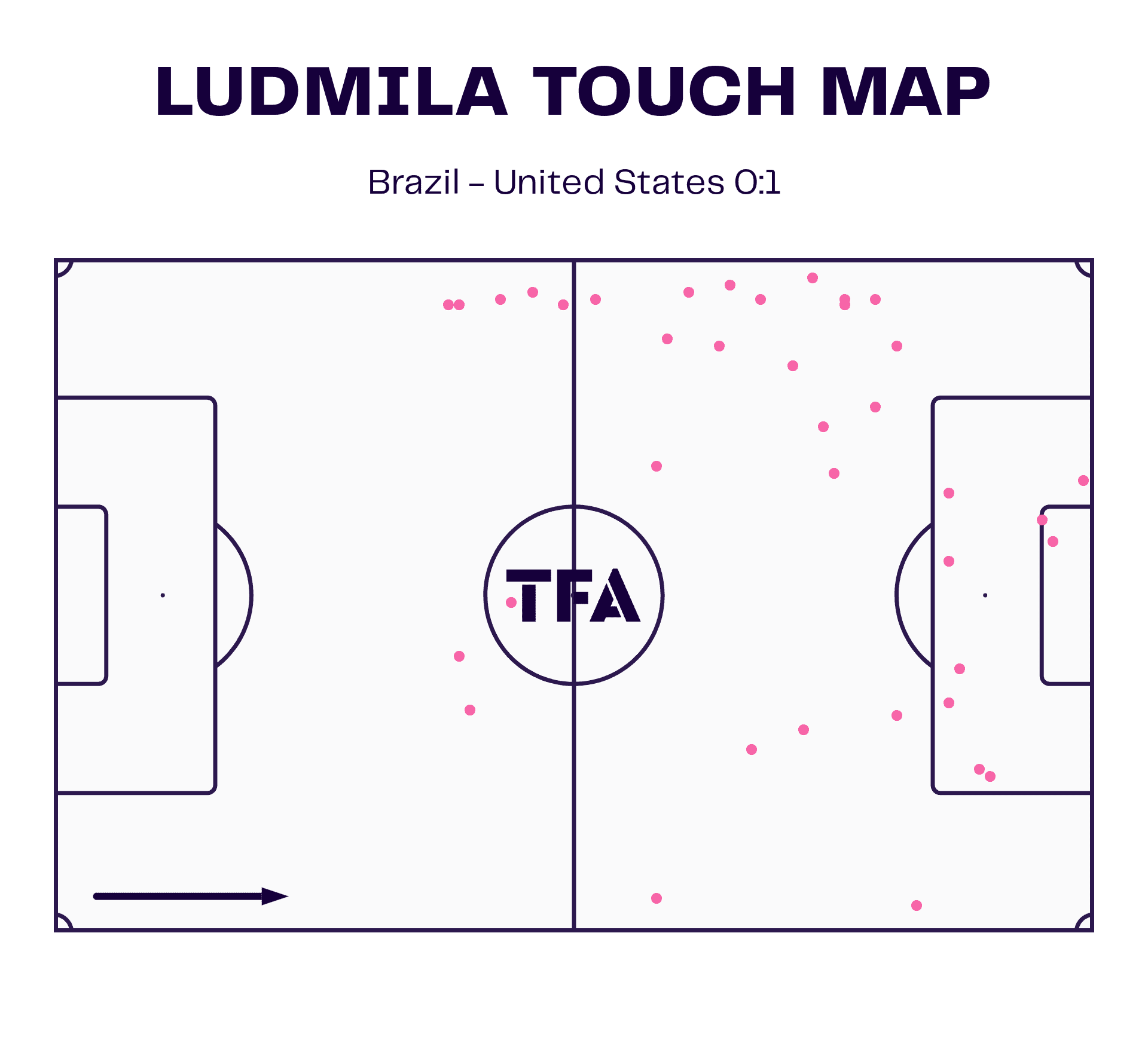
What really made this style of play possible was the role that Ludmila had, with her central to so much of what her side did well through her ability to both drop deep and wide to connect the play but also to make runs through gaps in the USA’s line and to give her team a target to find.
In the last situation, her positioning clearly created the opportunity for Sampaio to send the ball up the pitch and test the USA’s resolve.
This graphic indicates the number of touches she had and the spaces in which they came.
It is immediately apparent just how high she got up the field and, therefore, how vital she was to Brazil’s direct tactics working so effectively.
Therefore, when looking at the reasons that they would have been the happier team going into the break, her presence and overall performance has to be factored into the equation.
Brazil Women’s Shortcomings
However, despite all of that, there is no getting away from the fact that Brazil failed to secure the gold medal (with this being the third time that they have finished as Olympic runners-up).
Therefore, it is important to look at what didn’t go so well for them and to show why they were unable to end their long wait to stand on the top step of the podium.
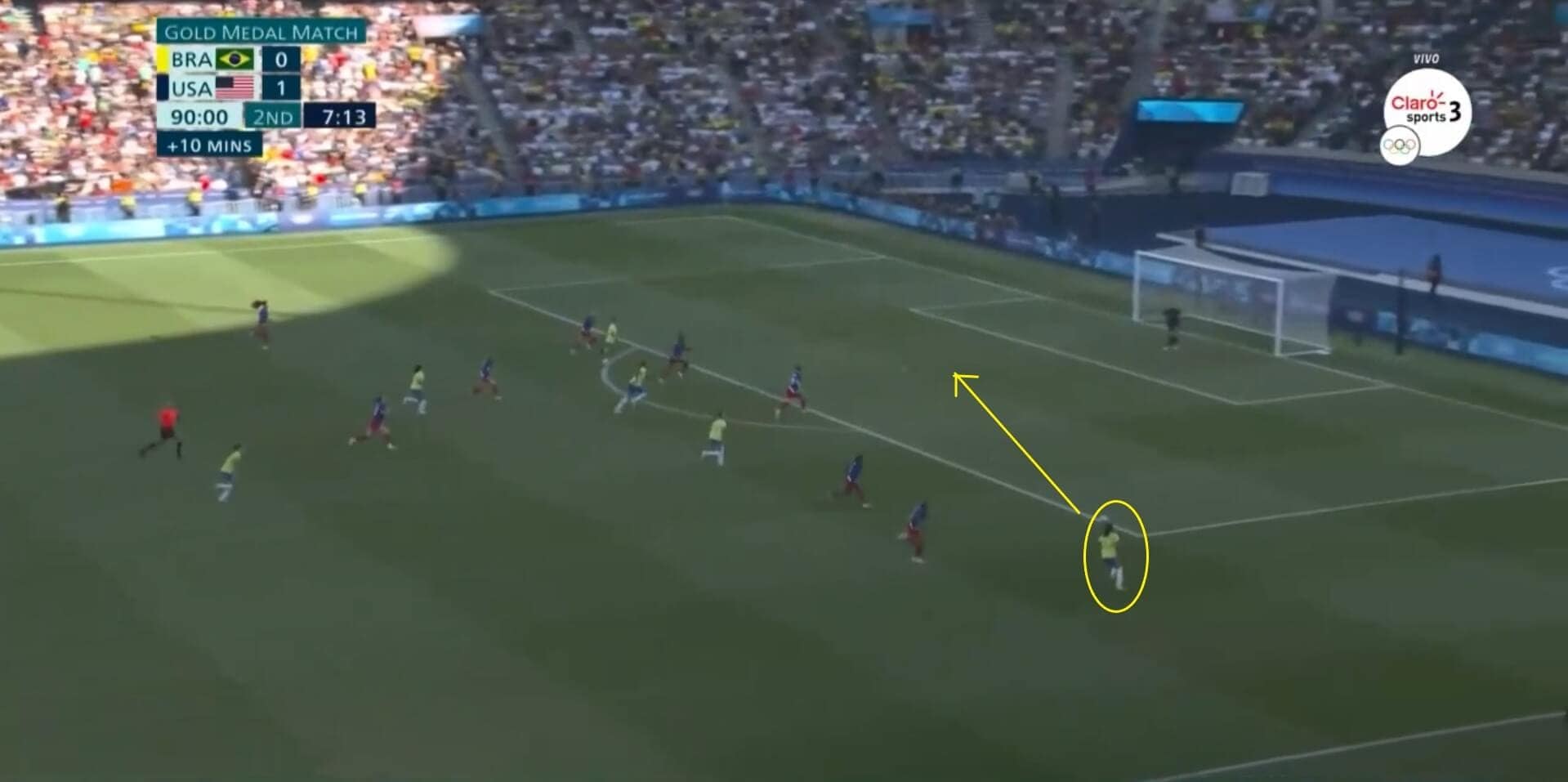
The first thing to mention with regards to this was not necessarily a problem that they created but was more a case of them needing to adapt after the break, with them not being able to construct attacks in the same way.
To explain, the USA altered their shape midway through the first half and put a stronger emphasis on controlling the central channel, and that led to Brazil being unable to build through the middle with those same long passes and needing to find alternative routes into the goal area.
This led to them turning to the wing play that has become a hallmark of their performances under Elias so far.
The wing-backs push up the field and constantly look to either bridge the gap between the defensive and attacking areas of the pitch or offer width when the team is moving up the field.
This played particularly into Adriana’s strengths.
She is known for her pace and spatial awareness and is constantly seen outflanking the USA’s narrow backline in a bid to maintain her side’s overall offensive threat.
The issue came when the ball was at her feet, and she was looking to deliver it back into the middle.
That was when the USA’s newfound robustness allowed them to stay between the central attackers and the ball.
In this case, that led to Adriana’s cross not being met by a teammate but instead being easily gathered by Red Stars goalkeeper Alyssa Naeher under little pressure.
It was not the only time that the South Americans were left frustrated by the lack of reward for their dominance in possession.
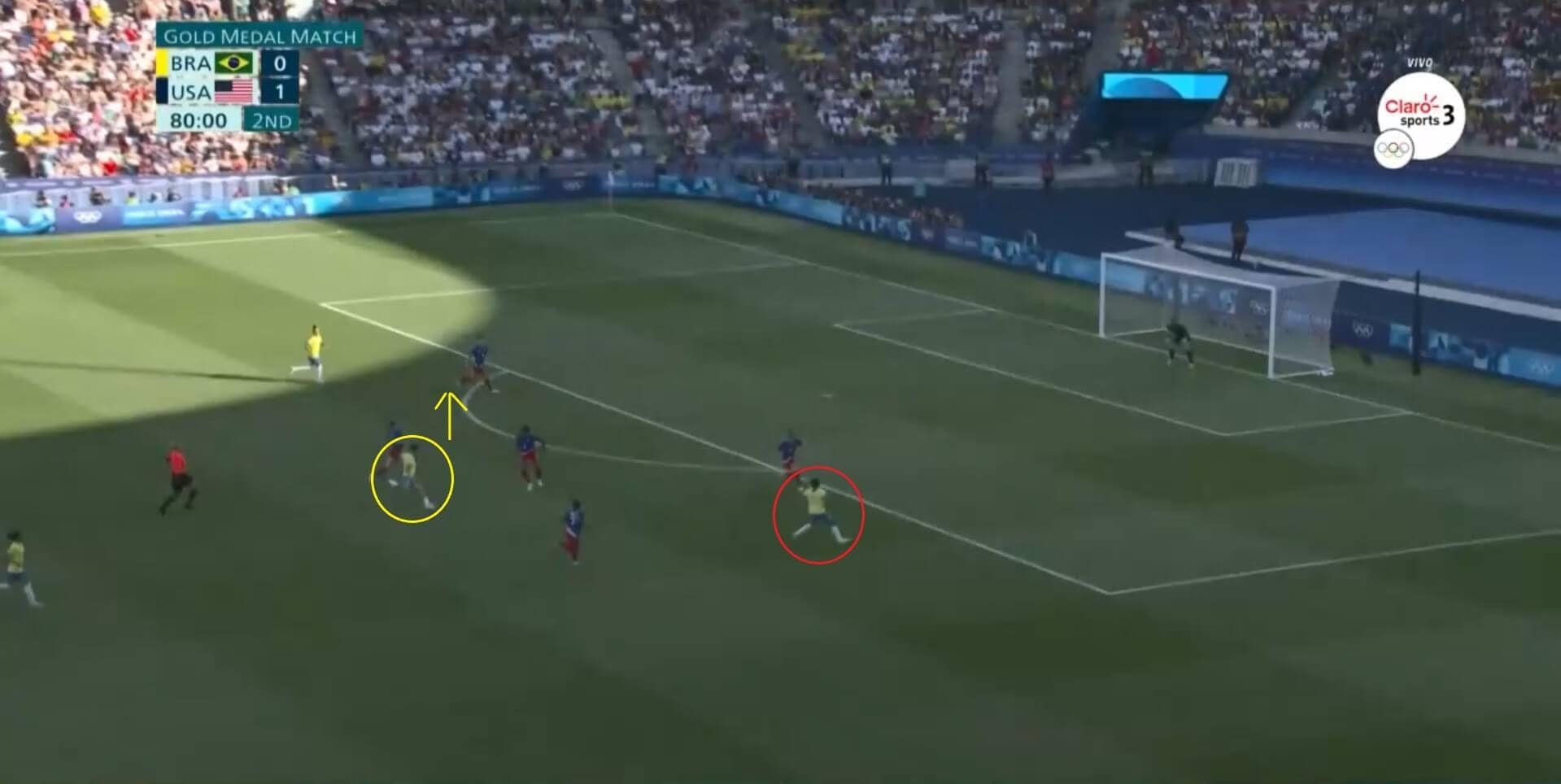
That is not to say that all of Brazil’s problems were the result of the USA’s change of system, though, and there were plenty of times when they were their own worst enemies.
Their lack of quality and poor decision-making were also increasingly apparent, and this situation really sums up how that let them down when they did get into promising areas.
As can be seen, Brazil have managed to manoeuvre the ball into a central attacking role and have caught the USA off-guard, and Portilho has a passing option in Marta on the nearside that could in all likelihood lead to a shot and maybe even a goal.
However, she opts not to send the ball towards the Orlando player and instead moves it across her body and out towards the far side of the field.
This was undoubtedly the harder pass to make here, and it gave the USA time to fall back into their shape that they should never have had.
It was clear to see how frustrated Marta at not receiving the ball here and it is understandable why, with her being in open territory and in the right place to try her luck at goal.
The ball did eventually travel in her direction as part of the secondary phase of the attack, but it was easily cut out before it could reach her and Brazil had wasted the opportunity.
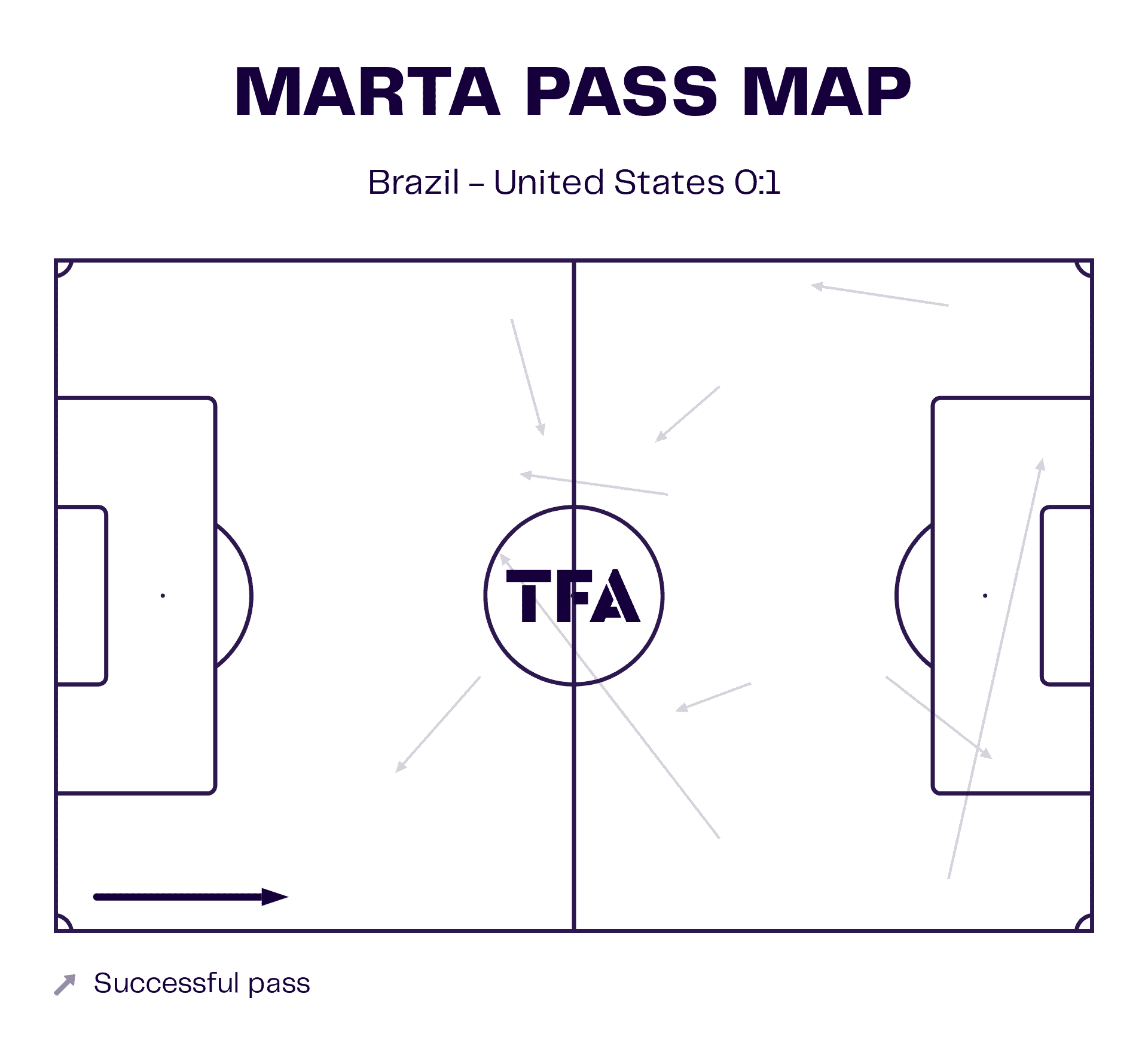
It was not the only time that Marta’s second-half introduction failed to pay off, though.
This graphic indicates how little impact she had on the match.
As can be seen, the few passes that she had were largely backwards, so she didn’t look to move the ball into any testing situations.
She only managed one shot on goal, and it came from further out, so it didn’t trouble the goalkeeper.
When Elias brought her on for Ludmila, it was perhaps designed to give his side a more creative player with the guile and know-how to thread passes between the USA’s compact defensive line.
The simple fact is that that never happened, and it was, therefore, another key reason that Brazil ended up on the losing side.
The USWNT’s Tactical Changes
None of this should take anything from the USA’s performance, though.
What was really noteworthy about their display was how they made a slow start and suffered for periods of the match but then found solutions to remedy those issues.
It is that that has really stood out about their time under Hayes so far, both in the run-up to and during the Olympics, and it was once again key to them ending the match on the right side of the scoreline.
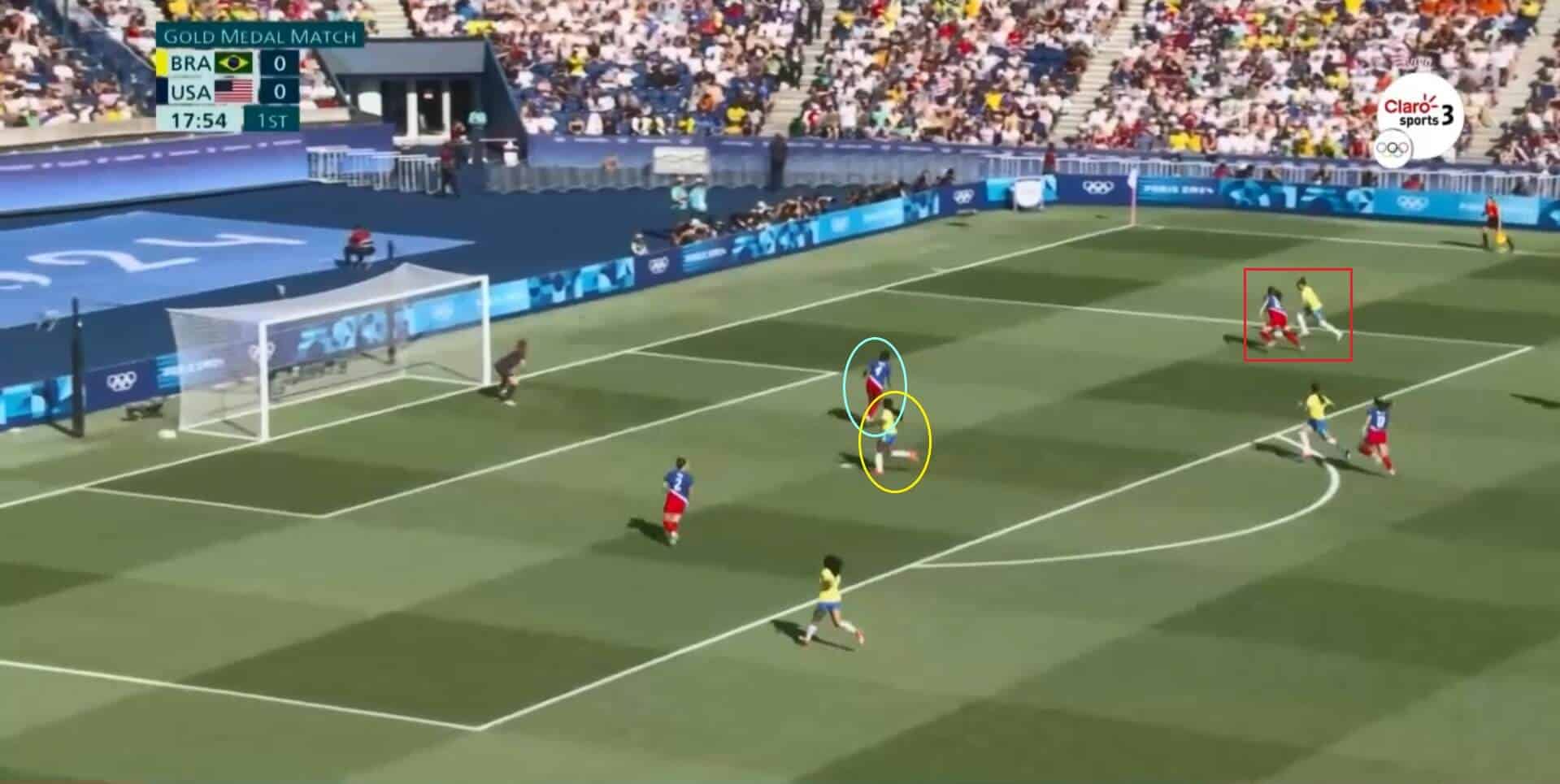
In many ways, their initial struggles were down to their own problems rather than the pressure that Brazil put them under, with it already clear that the USA can negate the threat of counterattacks and long ball tactics due to the way that they dealt with Zambia when the two met in the opening round of matches.
However, for one reason or another, the USA looked very tentative in this encounter and played with plenty of hesitation in the first half, and this situation highlighted how dangerous that became for them.
Portilho has possession on the far side of the field and is looking for a way to deliver the ball into the middle.
Ludmila once again moves between the lines and tries to provide a target for her teammate to find.
The player to look at here is Naomi Girma, who is in the middle of the goal area and who is normally very difficult to get past.
With her being the closest to Ludmila here, it is her responsibility to mark her and to prevent the ball from reaching her, but the issue comes in that the San Diego Wave player has turned her back completely on the forward, and so has no knowledge of her whereabouts.
Couple this with her decision not to get a foot on the ball when Portilho did send it in, which risked Brazil shooting at goal from close range, and there is no doubting that the USA were really playing a dangerous game here.
In the end, the chance didn’t come to anything, likely due to Ludmila expecting Girma to clear her lines or to put the ball behind for a corner, but it was a warning and was one that the USA failed to heed as the half went on.
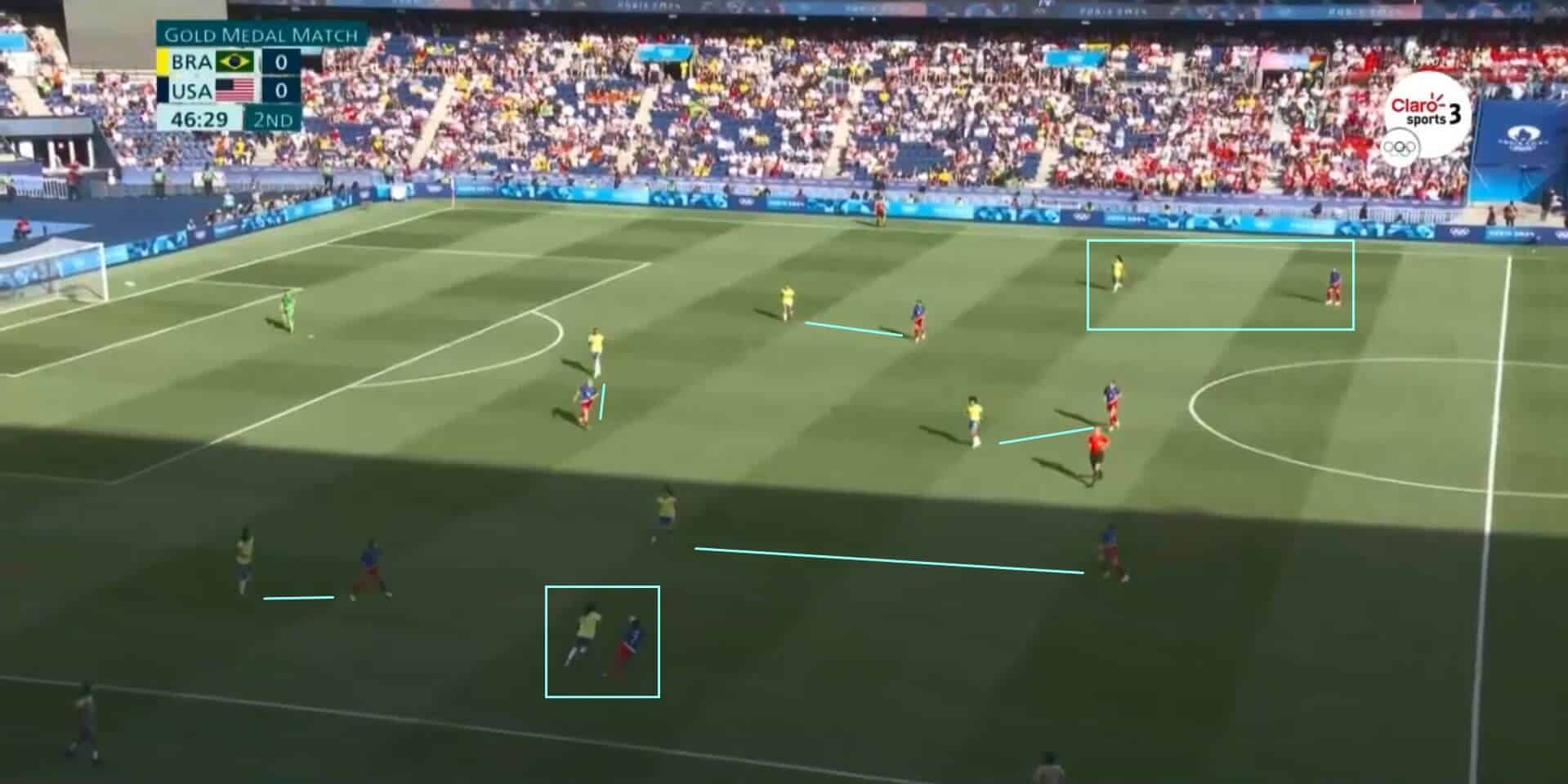
For this reason, and because the USA lacked both midfield control and an attacking threat with just one player at the top of the field, Hayes and her staff decided to abandon the 4-2-3-1 system.
In its place, they adopted a 3-4-3 wing-back shape, and it had an immediate positive effect.
It gave them more balance and allowed them to go player-to-player during those long periods of play when they were out of possession.
That latter part can be seen here, with the front three taking one of Brazil’s three centre-backs each, while the midfielders and wing-backs mark their opposite numbers, too.
This also affected Brazil’s play, and it is here that they started to realise how their previous methods of building play had been cut out.
To explain, goalkeeper Lorena and the back three had been able to play around the USA’s attack most of the time that Hayes’s side had been in the 4-2-3-1 shape, but they were now forced to make more longer passes and to try harder to find the areas where the USA could be opened up.
By doing so, they only increased Hayes’ team’s opportunities to win more first balls, though, and so this formation change was key in turning the game in the USA’s favour.
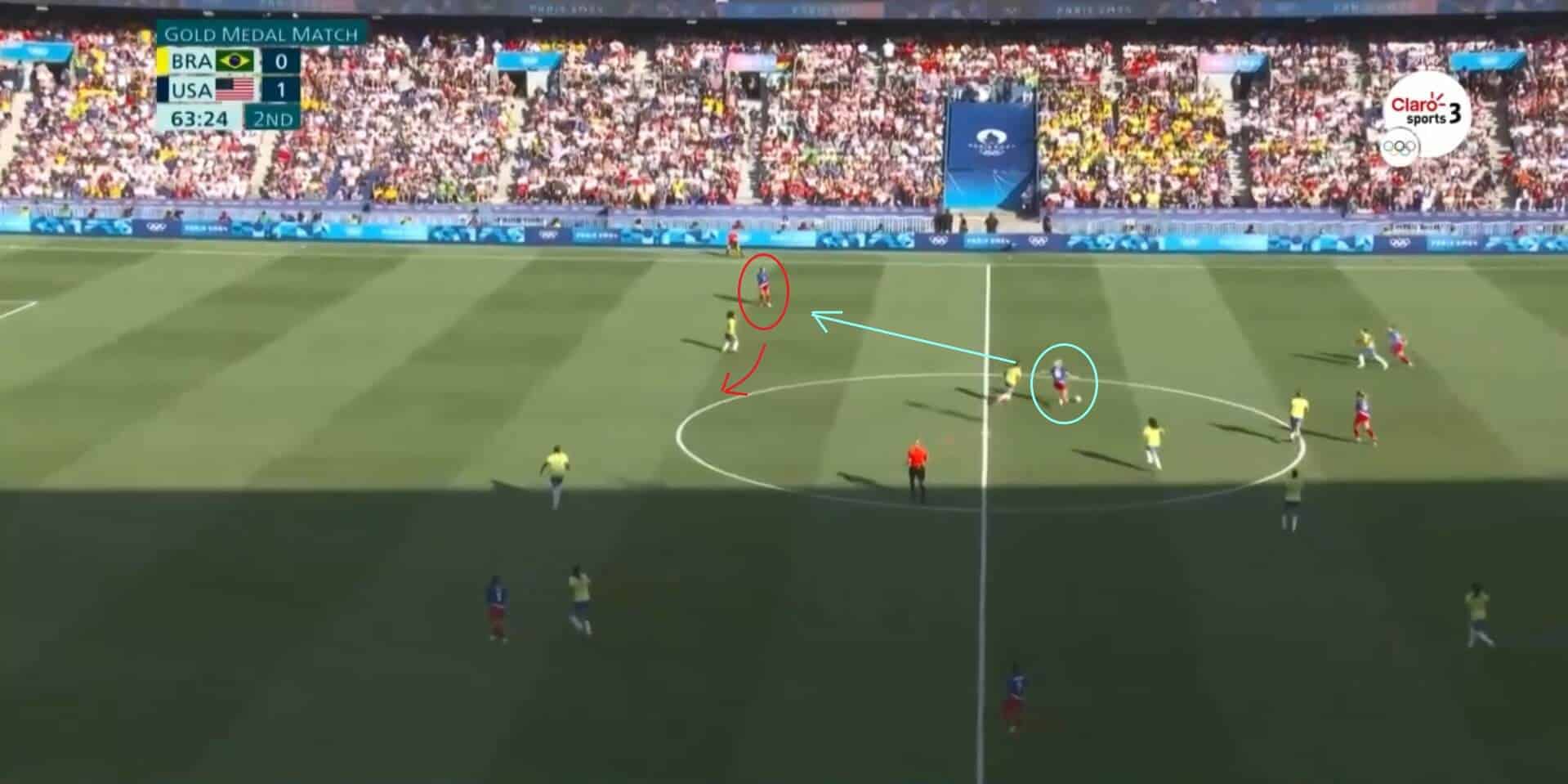
It is worth pointing out that a few players had very specific roles within that shape, with Horan being one of them.
While a midfielder by trade, Hayes asked her to move up the field and operate as a false nine in this new structure, which might initially sound strange.
However, there was a very clever reason behind this move.
Horan naturally drops back and looks to get plenty of touches of the ball during transitions, and so Hayes knew that she would tempt the Brazilian players in her vicinity into following her.
This would then leave gaps open behind them that would give others chances to move forward and to create overloads in advanced positions, which was a strategy that really paid off for the champions as the match went on.
In this case, it is substitute Angelina who has moved to track Horan into the central third, and that has then opened up a gaping hole for Rodman to cut inside Yasmim (winning one of her signature 1-v-1 battles in the process of doing so) and to exploit.
The Washington Spirit attacker might not have seen her resulting effort on goal come to anything on this occasion, but the fact that the USA’s goal came from a similar sequence of decisive passes and speed through the middle from scorer Swanson showed how key this tactical transformation was in getting them over the line and allowing them to return home with another gold medal to add to their honours list.
Conclusion
In conclusion, this tactical analysis has looked in detail at the 2024 Paris Olympics women’s football final, highlighting the reasons that the USA managed to come out on top and that Brazil ended up falling just short.
As the analysis has gone on, it has become abundantly clear that Brazil did a lot of things right during the encounter and can be proud of its overall performance. They made life difficult for the US Women’s National Team and forced them to really dig deep to get the win.
However, there will be no consoling them when it comes to their failure to hand Marta the perfect farewell present, with the legendary playmaker highly likely to have now played her final match for her country.
From the USA’s point of view, it came down to their ability to change things up when the chips were against them, and that has not always been their forte in recent years.
However, having multiple ways of playing is something that Hayes has really instilled into her new squad since formally arriving earlier in the summer, and the fact that they now have the ability to fluctuate between shapes and tactics highlights just how far they have come under her guidance.
The fact that they have won the Olympics will give everyone connected with the side confidence that they are moving in the right direction once again, and there will be a lot of hope that this is the first of many successes that they attain with her at the helm.





Comments